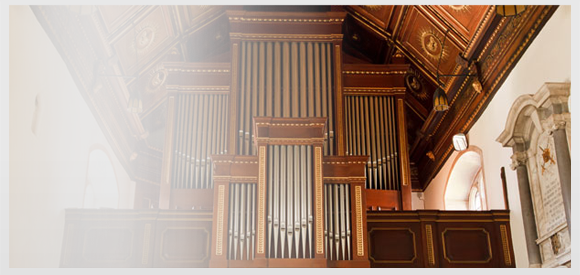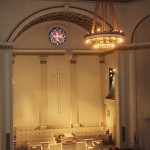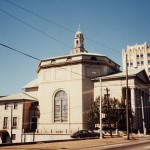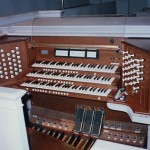First Presbyterian Church
On Sunday, June 21, 1840, two men, who had served at the Brainerd Mission to the Cherokee Indians east of town before the indians removal in 1838, organized the Presbyterian Church of Chattanooga. The first offering was given for missionary support, marking the beginning of what continues as a very important ministry of the church. Today, First Presbyterian’s 2,500 members annually give over $1 million to missions projects and partially suport more than 200 missionaries.
The church’s first worship services were held in a log cabin near 5th and Lookout Streets. The first church building was built in 1845 on the west side of Walnut Street near 3rd Street. The church allowed other churches to worship as well. This building served until the mid-1850s, when a new building was erected at the NE corner of 7th and Market Streets. When the Union Army occupied the city in 1863, the church was stripped for use as a Union hospital. The church continued to meet, but at the home of pastor T. Hooke McCallie at the NE corner of McCallie and Lindsay. This home later became the original location of Baylor School, ironically enough. When some members split off to form Second Presbyterian Church in 1871, the Presbyterian Church of Chattanooga became First Presbyterian Church.
In the 1880s, a new worship facility was built at the SW corner of Georgia and 7th. It served until 1910, when the present worship facility was opened. The design of the new sanctuary came from the famous New York architect Stanford White’s plans for Madison Square Presbyterian Church in Manhattan, adapted for the Chattanooga congregation by a local architect. Various buildings were added through the years, the most prominent of which was the annexing of the neighboring former Medical Arts tower in 1981.
The church’s first organ was also the first organ in Chattanooga. It was built and installed in 1878 by a ruling elder of the church, John Fernquist. He ordered the metal pipes from his home country of Sweden, but the wooden parts and pipes of the organ were crafted locally. It was transplanted to the 1884 facility and was expanded and used until the present facility was built. A 2-manual Pilcher of 25 stops, Opus 680, was installed in the new sanctuary behind an elegant Georgian-style case in the high front gallery. In 1926, Austin installed their Op. 1415, a 3-manual of 27 ranks. When the Pilcher was removed, the back hall beneath the organ was absorbed into the sanctuary for a high rostrum-level choir loft. The Austin was installed in new organ chambers in their present locations to each side of the choir, but fronted with fancy grillwork. The choir loft was lowered in 1959.
Following is the stoplist of the Austin organ. The price was $16,400 for thirty ranks and the contract was signed for the church by J. T. Lupton. The check was sent to Austin for the church by Mr. Lupton, c/o The Stone Fort Land Co. My thanks to David Cooper for providing an original copy of
the contract.
Austin Organ Co., Inc., Op. 1415, 1927, 3/27
GREAT (under expression with Choir)
8′ Open Diapason 73 pipes metal
8′ Viol D’Gamba 73 pipes metal
8′ Gross Flute 49 pipes wood (from Pedal 16′ Open Diapason)
4′ Octave 73 pipes metal
4′ Wald Flute 73 pipes wood
8′ Harmonic Tuba 73 pipes reeds
Sub
Unison Off
Super
Cathedral Chimes – Deagan, Class “A”
SWELL
16′ Bourdon 73 pipes wood
8′ Diapason Phonon 73 pipes metal
8′ Tiba Clausa 73 pipes wood
8′ Viole D’Orchestre 73 pipes metal (block tin)
8′ Viole Celeste 61 pipes metal (block tin)
8′ Echo Salicional 73 pipes metal
4′ Flauto Traverso 73 pipes wood
2 2/3 Nasard 61 pipes metal
2′ Flautino 61 pipes metal
1 3/5′ Tierce 61 pipes metal
III Mixture (draws 2 2/3′, 2′, 1 3/5′)
16′ Bassoon 61 pipes reeds
8′ Cornopean 73 pipes reeds
8′ Oboe 12 pipes
8′ Vox Humana 61 pipes reeds (sep chest, swell box and tremolo)
Tremolo
Sub
Unison Off
Super
CHOIR
8′ Violin Diapason 73 pipes metal
8′ Dulciana 73 pipes metal
8′ Concert Flute 73 pipes wood
4′ Rohr Flute 73 pipes wood
8′ French Horn 73 pipes reeds
8′ Clarinet 73 pipes reeds
Tremolo
Sub
Unison Off
Super
PEDAL
32′ Sub Bass (resultant)
16′ Open Diapason 32 pipes wood
16′ Bourdon Grande 32 pipes wood
16′ Bourdon Amabile SW
8′ Flauto Major 12 pipes wood
8′ Flauto Dolce 12 pipes wood
8′ Violoncello GT
16′ Tuba Profunda 12 pipes
16′ Bassoon SW
ECHO
8′ Viola 73 pipes metal
8′ Flaudo Dolce 73 pipes wood
8′ Unda Maris 73 pipes wood
8′ Vox Humana 61 pipes reeds
Echo off, Swell on
Swell and Echo on
Swell off, Echo on
Echo off, Choir on
Choir and Echo on
Choir off, Echo on
In 1970, Moller Op. 10629, with three manuals and 49 ranks, was installed. The grillwork was removed from the chambers at this time and the choirloft lowered yet again. The choir and organ have been featured for years across the United States and in many places around the world as part of the television ministry of the church, “Changed Lives.”
My thanks to churchmember and AGO Chapter member David Cooper for supplying this information, which I merrily borrowed from the fascinating book he wrote in 1991 about the church’s history. It is called “Catalyst for Christ – 150 Years.” It is probably available through the church or the CHATTANOOGA TIMES-FREE PRESS, where David is an editor. Anyone interested in Chattanooga history will love this book. Fortunately for the Chattanooga AGO Chapter, David is also an avid pipe organ afficionado.
M. P. Moller, Inc., Opus 10629, 1970, 3/49
| GREAT | SWELL | CHOIR | ||||||
| 16′ | Quintaton | 8′ | Rohrflote | 8′ | Holzgedeckt | |||
| 8′ | Principal | 8′ | Viola Pomposa | 8′ | Erzahler | |||
| 8′ | Bordun | 8′ | Viola Celeste | 8′ | Erzahler Celeste | |||
| 4′ | Octav | 8′ | Flute Celeste II | 4′ | Principal | |||
| 4′ | Spitzflote | 4′ | Principal | 4′ | Koppelflote | |||
| 2′ | Super Octav | 4′ | Flachflote | 2′ | Blockflote | |||
| IV | Mixtur | 2 2/3′ | Nazard | 1 1/3′ | Larigot | |||
| 8′ | Trompete | 2′ | Gemshorn | IV | Scharf | |||
| Unison Off | 1 3/5′ | Terz | 8′ | Krummhorn | ||||
| Super | III | Plein Jeu | Tremulant | |||||
| Chimes | 16′ | Basson-Hautbois | Sub | |||||
| 8′ | Festival Trumpet | 8′ | Trompette | Unison Off | ||||
| 8′ | Hautbois | 12 | Super | |||||
| PEDAL | 4′ | Clairon | Chimes | |||||
| Tremulant | 8′ | Festival Trumpet | ||||||
| 16′ | Principal | Sub | ||||||
| 16′ | Subbass | Unison Off | ||||||
| 16′ | Quintaton | GT | Super | |||||
| 16′ | Erzahler | 12 | ||||||
| 8′ | Octav | 12 | ||||||
| 8′ | Spitzflote | ANTIPHONAL | ||||||
| 8′ | Erzahler | CH | (unenclosed) | |||||
| 4′ | Choralbass | |||||||
| 4′ | Spitzflote | 12 | 8′ | Metallgedackt | ||||
| 2′ | Spitzflote | 12 | 4′ | Principal | ||||
| II | Rauschquint | 4′ | Gedackt | 12 | ||||
| II | Mixtur | 24 | 2′ | Principal | 12 | |||
| 32′ | Trumpet | 12 | ||||||
| 16′ | Trumpet | |||||||
| 16′ | Basson | SW | ||||||
| 8′ | Trumpet | 12 | ||||||
| 4′ | Trumpet | 12 | ||||||
| 4′ | Basson | SW | ||||||
| Chimes | GT | |||||||







